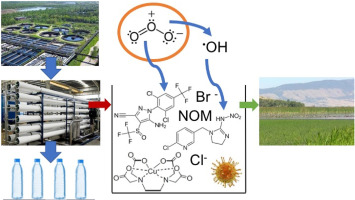当前位置:
X-MOL 学术
›
Water Res.
›
论文详情
Our official English website, www.x-mol.net, welcomes your
feedback! (Note: you will need to create a separate account there.)
Efficacy of ozone for removal of pesticides, metals and indicator virus from reverse osmosis concentrates generated during potable reuse of municipal wastewaters.
Water Research ( IF 11.4 ) Pub Date : 2020-03-23 , DOI: 10.1016/j.watres.2020.115744 Jacob F King 1 , Aleksandra Szczuka 1 , Zhong Zhang 1 , William A Mitch 1
Water Research ( IF 11.4 ) Pub Date : 2020-03-23 , DOI: 10.1016/j.watres.2020.115744 Jacob F King 1 , Aleksandra Szczuka 1 , Zhong Zhang 1 , William A Mitch 1
Affiliation

|
This study evaluated ozone treatment to address concerns regarding the discharge to marine waters of chemical contaminants and pathogens in reverse osmosis (RO) concentrates generated during the potable reuse of municipal wastewaters. Previous studies indicated that contaminants can be sorted into five groups based on their reaction rate constants with ozone and hydroxyl radical to predict degradation of chemical contaminants during ozonation of municipal effluents. Spiking representatives of each group into five RO concentrate samples, this study demonstrated that the same contaminant grouping scheme could be used to predict contaminant degradation during ozonation of RO concentrates, despite the higher concentrations of ozone and hydroxyl radical scavengers. The predictive capability of the contaminant grouping scheme was further validated for four contaminants of concern in RO concentrates, including the pesticides fipronil and imidacloprid, and the metal chelates Ni-EDTA and Cu-EDTA. After measuring their ozone and hydroxyl radical reaction rate constants, these compounds were assigned to contaminant groups, and their degradation during ozonation matched predictions. Addition of 300 mg/L CaO at pH 11 achieved partial removal of the native nickel and copper by precipitation. Ozone pretreatment further enhanced precipitation of nickel, but not copper. Ozonation achieved 5-log inactivation of MS2 in all five concentrate samples at 1.18 mg O3/mg DOC. Ozonation at 0.9 mg O3/mg DOC formed 139-451 μg/L bromate. Pretreatment of RO concentrates with chlorine and ammonia reduced bromate formation by a maximum of 48% but increased total halogenated DBP concentrations from 20 μg/L to 36 μg/L. Regardless, neither bromate nor trihalomethane concentrations exceeded threshold concentrations of concern for discharge to marine waters.
中文翻译:

臭氧从市政污水的饮用水回用过程中产生的反渗透浓缩物中去除农药,金属和指示剂病毒的功效。
这项研究评估了臭氧处理方法,以解决在市政污水的饮用水回用期间产生的反渗透(RO)浓缩物中化学污染物和病原体向海水排放的担忧。以前的研究表明,根据污染物与臭氧和羟基自由基的反应速率常数,可以将污染物分为五类,以预测市政废水臭氧化过程中化学污染物的降解。将每组的代表掺入五个RO精矿样品中,这项研究表明,尽管臭氧和羟自由基清除剂的浓度较高,但相同的污染物分组方案可用于预测RO精矿臭氧化过程中的污染物降解。进一步验证了RO精矿中关注的四种污染物的污染物分组方案的预测能力,其中包括杀虫剂氟虫腈和吡虫啉以及金属螯合物Ni-EDTA和Cu-EDTA。在测量它们的臭氧和羟基自由基反应速率常数之后,将这些化合物分配到污染物组中,并且它们在臭氧化过程中的降解与预测相符。在pH 11下添加300 mg / L CaO可以通过沉淀部分去除天然镍和铜。臭氧预处理进一步增强了镍的沉淀,但没有增加铜的沉淀。臭氧化在五个浓度为1.18 mg O3 / mg DOC的所有浓缩液样品中实现了MS2的5 log灭活。以0.9 mg O3 / mg DOC进行臭氧处理可形成139-451μg/ L溴酸盐。用氯和氨对RO精矿进行预处理最多可减少48%的溴酸盐生成,但将卤代DBP的总浓度从20μg/ L增加到36μg/ L。无论如何,溴酸盐和三卤甲烷的浓度均未超过排放到海水中所关注的阈值浓度。
更新日期:2020-03-24
中文翻译:

臭氧从市政污水的饮用水回用过程中产生的反渗透浓缩物中去除农药,金属和指示剂病毒的功效。
这项研究评估了臭氧处理方法,以解决在市政污水的饮用水回用期间产生的反渗透(RO)浓缩物中化学污染物和病原体向海水排放的担忧。以前的研究表明,根据污染物与臭氧和羟基自由基的反应速率常数,可以将污染物分为五类,以预测市政废水臭氧化过程中化学污染物的降解。将每组的代表掺入五个RO精矿样品中,这项研究表明,尽管臭氧和羟自由基清除剂的浓度较高,但相同的污染物分组方案可用于预测RO精矿臭氧化过程中的污染物降解。进一步验证了RO精矿中关注的四种污染物的污染物分组方案的预测能力,其中包括杀虫剂氟虫腈和吡虫啉以及金属螯合物Ni-EDTA和Cu-EDTA。在测量它们的臭氧和羟基自由基反应速率常数之后,将这些化合物分配到污染物组中,并且它们在臭氧化过程中的降解与预测相符。在pH 11下添加300 mg / L CaO可以通过沉淀部分去除天然镍和铜。臭氧预处理进一步增强了镍的沉淀,但没有增加铜的沉淀。臭氧化在五个浓度为1.18 mg O3 / mg DOC的所有浓缩液样品中实现了MS2的5 log灭活。以0.9 mg O3 / mg DOC进行臭氧处理可形成139-451μg/ L溴酸盐。用氯和氨对RO精矿进行预处理最多可减少48%的溴酸盐生成,但将卤代DBP的总浓度从20μg/ L增加到36μg/ L。无论如何,溴酸盐和三卤甲烷的浓度均未超过排放到海水中所关注的阈值浓度。











































 京公网安备 11010802027423号
京公网安备 11010802027423号